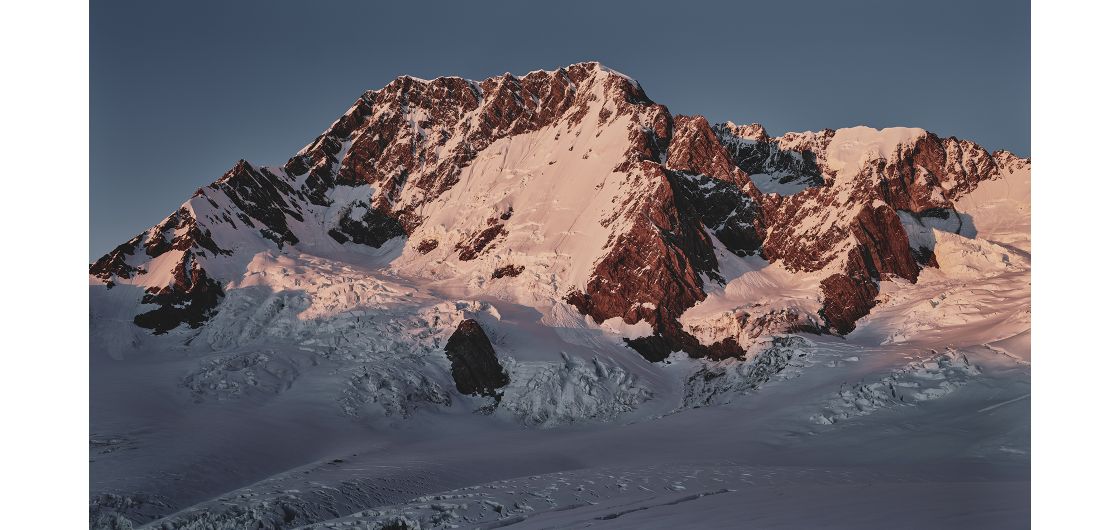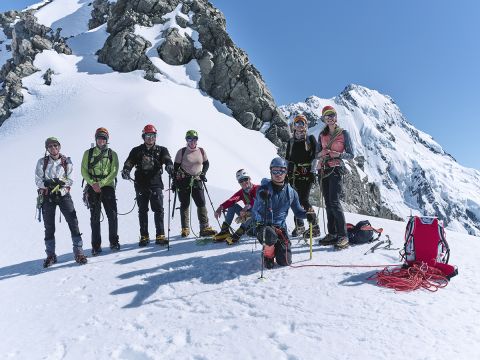
Arowhenua, Aoraki & Mountaineers: A Research Project - Finding The Balance
This series of articles first appeared in New Zealand Alpine Journal #79 (autumn, 2024). The other articles in this series can be found here.
Finding The Balance: Sharing Knowledge Between Mountaineers And Arowhenua
By Chris North
Phase 1 of the project showed that some Arowhenua whānau were deeply suspicious of what mountaineers were doing up on Aoraki Mt Cook. Because most Arowhenua whānau had not been up onto the high areas of the mountain, they didn’t have any direct experience of what mountaineers do. Instead, whānau pieced together available information from sources like documentaries showing piles of rubbish, human waste and dead bodies on Everest. Little wonder that mountaineers were not necessarily viewed in a good light. Similarly, the survey on mountaineers (Phase 2) showed low levels of knowledge about Māori tikanga /protocols. To address the mutual lack of understanding, we developed a knowledge exchange initiative with a small group of mountaineers and Arowhenua whānau.
Importantly, we wanted to avoid a situation where knowledge is only shared one way or where consultation is reduced to a ‘rubber stamping’ of something that has already been decided. The approach we chose to use is based on a tuakana/teina (older sibling/younger sibling) framework. Tuakana is the more experienced sibling and the teina is the less experienced sibling. The role of the teina is to ask questions, and explore topics and skills alongside the tuakana. In this relationship, both tuakana and teina are actively responding to each other. We hoped that by the end of the time together, both mountaineers and Arowhenua whānau would have a better understanding of each other and also done some much needed relationship building.
We also wanted to make sure there was balance of the different groups’ voices and roles. So we planned for five days with two days based in the mountains, and two days focused on the Arowhenua cultural practices. The fifth day would be used to pull together all the insights from the week. In a project like this, we are not so much testing a hypothesis, but creating the conditions for insights to emerge. There are many uncertainties. The idea is that by being really open with what might happen, we don’t limit the knowledge to answering key questions. Participants need to be able to handle a really open brief, and trust the process.
Participants
Mountaineers: Lydia Bradey, Tom Hoyle, Tanja de Wilde, Paul Hersey.
Arowhenua whānau: Michael McMillan, Felicity McMillan, Toni Torepe, Tobias Lomano.
Lydia was overall in charge of the mountain section and Michael was overall in charge of the Arowhenua journey.
What happened in more detail
It was a grey and rainy Monday morning when we travelled down from Christchurch to Temuka picking up people on the way. By the time we reached Unwin Lodge, the weather was coming right and the window allowed us to fly in to Plateau Hut. Lydia Bradey was overall in charge of the mountain activities and we spent the afternoon in pairs putting on harnesses, helmets, crampons and ropes, before going for a walk around the Plateau in the evening light. The shared meal was planned and prepared by the mountaineers with Lydia as head chef. As we ate dinner around the table in the hut, we discussed a variety of topics, some very broad, and others much more focused on human waste up on the mountains. We were up at dawn and watched the first glow spread over the high peaks. Mountaineers and their Arowhenua partners roped up in pairs and ascended towards Glacier Dome. In many ways it was the perfect morning with a layer of cloud below us stopping any flights, not a breath of wind, and the warm morning light making all the mountains peachy. After some mountain appreciation or glacier walking options for the early afternoon, we flew back down and regrouped at Unwin for a debrief on the mountaineering experience.

On Wednesday morning, we drove back to Temuka with Michael McMillan from Arowhenua taking a lead on the route and stops. For example, we stopped at Pūkaki, and Michael described the island that had been in the lake before the dam. Evidence of seasonal and longer-term settlements dotted the landscape and the many names for the different places show evidence of extensive knowledge of Arowhenua in the Manahuna (McKenzie Basin) and also the peaks and glaciers. Arowhenua are now largely a coastal people but were once far more widely distributed and Michael’s narratives from the places we visited have survived 200 years of renaming places and erasing stories. Down at the Pā, the mountaineers were welcomed on and met with Tewera King, who is the ūpoko of Arowhenua. Toni helped the mountaineers understand the tikanga/protocols at the marae so that people would better understand what to do/ not do. We visited the nursery set up by Felicity (and where Tobias works), to provide seedlings from locally sourced seeds and saw their work on plantings around the waterways. The cave painting centre in Timaru provided some examples of Arowhenua cave art and the history of the travels inland. The ki tai session ended with an nighttime eeling trip up the river (an important mahinga kai /food gathering) location.
On the final day, Hana O’Regan ran a review of the week and brought together the different threads, taking into account the way the project attempted to balance the voices of participants. With poster paper and pens we compiled themes of whanaungatanga/relationships and connections, tikanga/ cultural learning (both ways), te taiao/environment, and attitude. The duration and intensity of the five days meant that participants found it difficult to distil the outcomes of the project into a few key points. Follow-up interviews are ongoing, so analysis and results are not complete.
Initial insights
Probably the biggest gain in understandings was that both the Arowhenua whānau and the mountaineers recognised the others care deeply for the land. For example, the mountaineers discussed how connected to the land they felt when in the mountains and discussed how they loved introducing others to the mountains. Mountaineers discovered that Te Rūnanga o Arowhenua are committed to looking after their lands. For example, Arowhenua are asked to comment on 3000 consent applications a year, some of which can have major impact on waterways or other ecological or cultural values. Arowhenua submissions on these consents try to make sure that, wherever possible, the applications will result in improvements rather than negative impacts on the land or waterways. They also have a proud record of responding within timeframes to these consents. In addition, Arowhenua have established a nursery and are actively planting to improve the water quality of the streams that have become polluted. The insights showed a shared and collective responsibility to the land, expressed in different ways by mountaineers and Arowhenua.
Mountaineers and Arowhenua whānau have important tikanga/protocols to uphold. Some of these are skills like not stepping on the rope, and how to behave in mountain huts (e.g. hygiene practices), others are how to behave in a wharenui (being careful of tapu things such as areas where food is prepared) alongside techniques for eeling. Underpinning the interactions was a sense of relationships being built up. The building of the relationship is perhaps more possible in a situation where the participants in the research were selected because they were interested in the outcomes—this also represents a limitation for this research. For example, taking a random sample of mountaineers and Arowhenua whānau would likely result in very different outcomes and perhaps not reveal the same level of mutual understandings. What the study has shown is that spending time together in each other’s areas and contexts has built respect and insights.
Clearly the project is not completed yet, so findings are tentative. What our initial findings suggest is that this was a powerful experience for participants and one that impacted on the way they viewed themselves and the other group.
